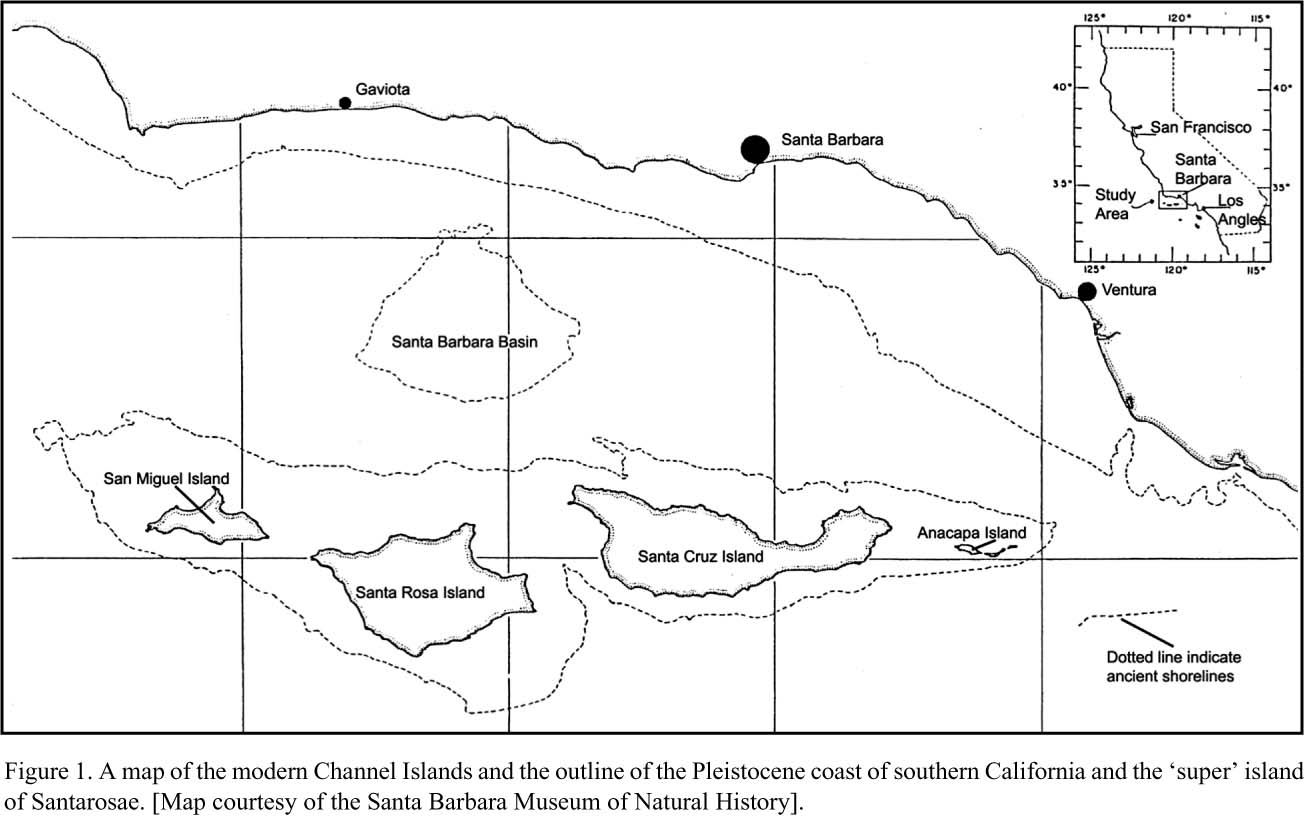
 The skeleton of the Pygmy Mammoth (Mammuthus exilis) in
the Channel Islands National Park Visitor Center is a replica
of the original that was found on Santa Rosa in 1994. This
example is about 90% complete and the only almost complete
specimen in the world.
The skeleton of the Pygmy Mammoth (Mammuthus exilis) in
the Channel Islands National Park Visitor Center is a replica
of the original that was found on Santa Rosa in 1994. This
example is about 90% complete and the only almost complete
specimen in the world.
Pygmy Mammoths are thought to be related to Columbian Mammoths
(Mammuthus columbi) found on the mainland. But how did 14-foot high
mammoths turn into the 8-foot pygmys?
 That begins with the Pleistocene Glacial
Epoch (1.6 million to 10,000 years ago). With large volumes of
ocean water trapped in continental ice sheets, sea levels were
approximately 100 to 125 meters lower than they are today.
This exposed land that connected the four northern Channel
Islands (San Miguel, Santa Rosa, Santa Cruz, and Anacapa) into
a single large island that has been named Santarosae. At the
closest point, the island was only five miles off the coast.
The dotted line on the figure approximates the coast lines of
Santarosae and the mainland during the Glacial Epoch.
That begins with the Pleistocene Glacial
Epoch (1.6 million to 10,000 years ago). With large volumes of
ocean water trapped in continental ice sheets, sea levels were
approximately 100 to 125 meters lower than they are today.
This exposed land that connected the four northern Channel
Islands (San Miguel, Santa Rosa, Santa Cruz, and Anacapa) into
a single large island that has been named Santarosae. At the
closest point, the island was only five miles off the coast.
The dotted line on the figure approximates the coast lines of
Santarosae and the mainland during the Glacial Epoch.
With some environmental stress on the mainland such as drought
or wild fire, the smell of fresh food on the islands drew a
population of Columbian Mammoths to swim the 5 miles to Santarosae
as long ago as 60,000 years ago. The assumption that Columbian
Mammoths have a good sense of smell is based on the fact that
modern day elephants have a very good sense of smell. Modern day
elephants have also been known to swim long distances, so it is
reasonable that prehistoric mammoths could also swim long
distances.
Once on the island the limited amount of food quickly favored
smaller individuals. Smaller individuals also had an easier time
negotiating the steep hills of the island. As a result the
population of mammoths quickly shrank to the pygmy size by 47,000
years ago. As an interesting note, at about the same time, deer
mice marooned on the island grew larger becoming giant deer
mice.
This observation of small continental species growing larger and
large continental species growing smaller on an isolated island is
referred to as Foster’s rule. In general, animals smaller than a
rat tend to get bigger, and those larger get smaller.
Evidence of diminutive mammoths have been discovered other
islands around the world, but each is a separate species and
population.
As the ice age waned and continental ice sheets melted, ocean
levels slowly inundated Santarosae. It is thought at about 10,000
years ago the individual Channel Islands became isolated from each
other by the rising sea level. It is thought that the Pygmy
Mammoths didn’t just swim back to the mainland because the never
smelled it. There is a predominant on-shore flow predominantly so
the Pygmys never had a strong enough impetus to swim back to the
continent. (However, the proof of that would be difficult to come
by.)
Obviously the Pygmy Mammoths eventually died out. Overcrowding,
a shrinking land mass, drought, or fire may have lead to the
extinction of the Pygmy Mammoths. Human activity on the island has
been shown to date back to 11,000 years, so it is also possible
that humans had a hand in their extinction.
Logging requirements:
Send me a note with :
- The text "GCZ5HB Pygmy Mammoths of the Channel Islands NP" on
the first line
- The number of people in your group.
- From the display find out how this mammoth was fossilized and
why the preservation was so good. Send me a note with the
information.
- Without touching the disply, compare the length of your
own arm to the length of the tusk.
- Sign the visitor log and include that you are
earthcaching.
The following sources were used to generate this
cache:
- L.D. Agenbroad, 2001, Channel Islands (USA)
pygmy mammoths (Mammuthus exilis) compared and contrasted with M.
columbi, their continental ancestral stock, The World of Elephants
- International Congress, Rome 2001, pgs 473-475
- LARRY D. AGENBROAD AND DON P. MORRIS, 1999,
GIANT ISLAND/PYGMY MAMMOTHS: THE LATE PLEISTOCENE PREHISTORY OF
CHANNEL ISLANDS NATIONAL PARK, in NATIONAL PARK SERVICE
PALEONTOLOGICAL RESEARCH VOLUME 4, EDITED BY Vincent L. Santucci
and Lindsay McClelland October 1999, pgs 27 - 31
- Paul Porcasi, Judith F. Porcasi, and Collin
O’Neil, 1999, Early Holocene Coastlines of the California Bight:
The Channel Islands as First Visited by Humans, in Pacific Coast
Archeological Society Quarterly, Volume 35, Numbers 2 & 3,
Spring and Summer 1999
- LARRY D. AGENBROAD, JOHN R. JOHNSON, DON MORRIS
AND THOMAS W. STAFFORD, JR., 2003, MAMMOTHS AND HUMANS AS LATE
PLEISTOCENE CONTEMPORARIES ON SANTA ROSA ISLAND, in Proceedings of
the Sixth California Islands Symposium, Ventura, California,
December 1 – 3, 2003, Edited By David K. Garcelon and Catherin A.
Schwemm, National Park Service Technical Publication
CHIS-05-01.
- Elaine Miller Bond, 2000, Mammoths downsized
for living on Santa Barbara Channel Islands, Transect, Summer 2000
18:1
Placement approved by the
Channel Islands National Park